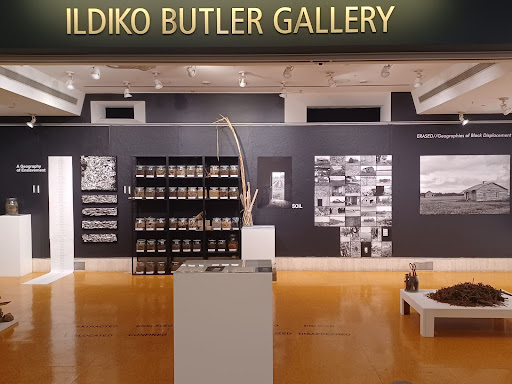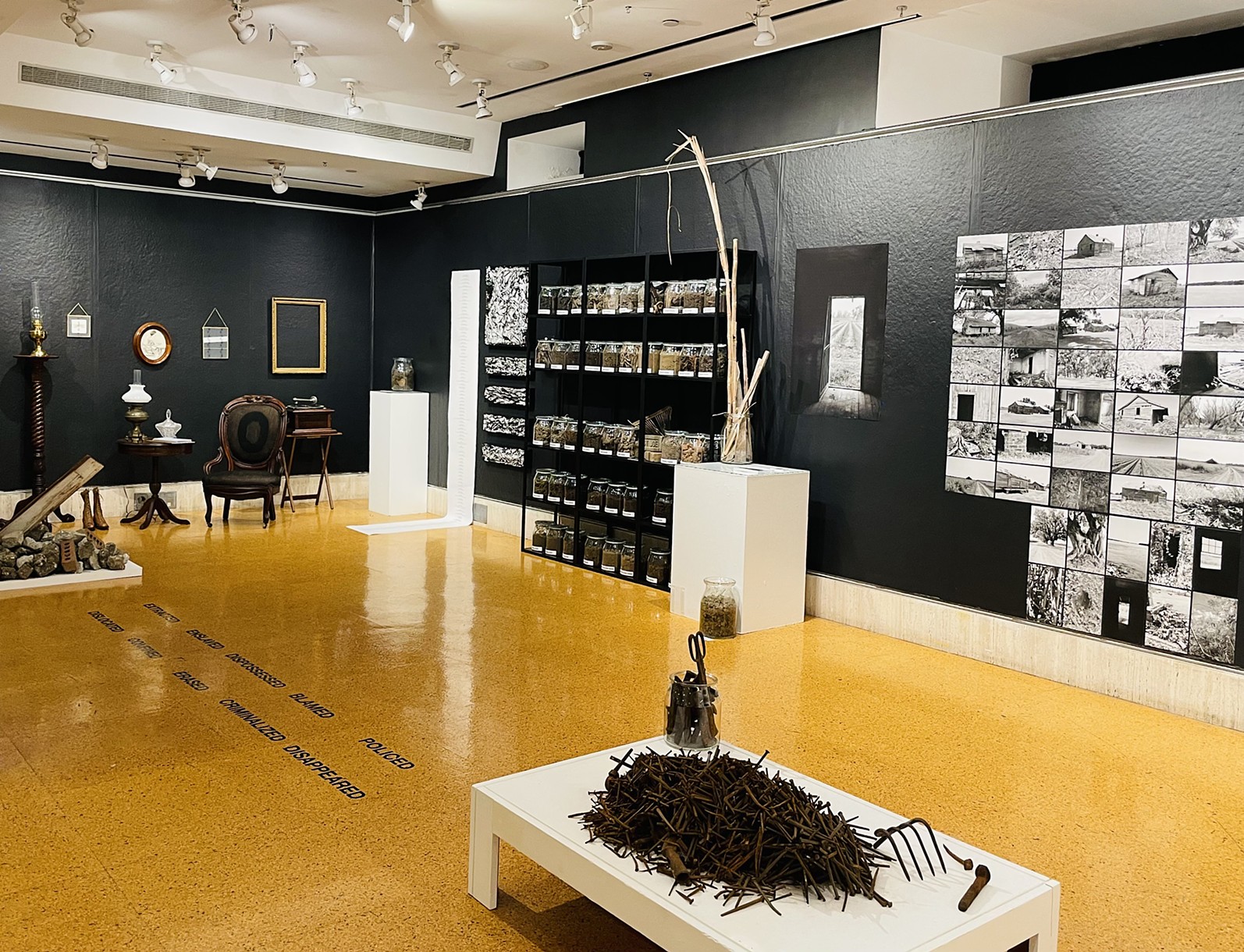ERASED-Geographies of Black Displacement
Overview
In 2022, the Visual Arts Department at Fordham was awarded a Teaching Race Across the Curriculum grant in support of an exhibition by the New Orleans–based Black feminist activist, sociologist, geographer, and artist Shana M. griffin. griffin's work in all of these capacities is deeply rooted in community engagement. Her show, ERASED//Geographies of Black Displacement, which opened in Fordham's Ildiko Butler Gallery on June 19 and will run through October 30, interrogate policies and practices of Black erasure, enslavement, disposability, and disappearance spatialized in the landscapes of Southeast Louisiana, New Orleans, and New York City — past and present. Combining archival research, found objects, photographs, text art, paintings, installations, and ephemera, ERASED engages the multiple ways displacement takes place, shapes Black life, and becomes sites of everyday violence, subjectivity, resistance, and possibilities.

Process
griffin worked closely with professors Casey Ruble and Diana Kamin and their students in Ruble’s Visual Justice and Kamin’s Photography, Identity, Power CEL courses to conduct research on Black displacement and enslavement in New York City. Student research in both courses informed griffin’s approach. griffin also engaged with students from Professor Matthew Lopez-Jensen’s CEL course Art + Action on the Bronx River and Professor Mark Street’s Making Art in Hell’s Kitchen; with David Shuffler, Executive Director of Youth Ministries for Peace and Justice, and his staff; and with Margarita Curet, former President of the Amsterdam Houses Tenants Association.

Location
Lincoln Center, Ildiko Butler Gallery
Faculty
Community Partner
Testimonial
“ERASED//Geographies of Black Displacement explores a range of themes interrogating the material consequences of Black displacement, fungibility, disposability, and erasure,” said researcher, artist, and feminist activist Shana M. griffin. “Working on the exhibition, engaging archives and historical sites, meeting with community organizations and professors, faculty, and students at Fordham University at Lincoln Center over the past year has been an incredible experience. Professor Ruble’s invitation has allowed me an opportunity to deepen the work of the DISPLACED project, from which the exhibition themes emerge, and expand its visual language.”
Outcomes
Programming surrounding the exhibition will bring in faculty, students, and scholars from other areas of study, both academically and community-based, and will take place at the beginning of the fall 2023 semester.
Project status
Complete
Resources:
Projects, Initiatives, and Organizations:
- DISPLACING Blackness: Cartographies of Violence, Extraction, and Disposability: https://www.displacingblackness.com/
- DISPLACED: https://displacedneworleans.com/
- Slave Voyages: https://www.slavevoyages.org/
- Slavery in New York Virtual Exhibition: http://www.slaveryinnewyork.org
- African Burial Grounds, National Monument New York City: https://www.nps.gov/afbg/index.htm
- Slavers of New York Instagram account: https://www.instagram.com/slaversofny/?hl=en
- Manhattan Street Names Tied to Slavery listed from A to Z: https://www.newyorkalmanack.com/2021/10/manhattan-street-names-tied-to-slavery-from-a-to-z/
- Landmark West NYC’s project on the San Juan Hill neighbor: https://www.landmarkwest.org/sjh/
- Lincoln Center’s Legacies of San Juan Hill web portal: https://lincolncenter.org/feature/legacies-of-san-juan-hill
- Undesign the Redline: http://www.designingthewe.com/undesign-the-redline
- Mapping Inequality: https://dsl.richmond.edu/panorama/redlining/
- Eviction Lab: https://evictionlab.org/
- Anti-Eviction Mapping Project: https://antievictionmap.com/
- Office of Metropolitan History: https://www.metrohistory.com/
- Library of Congress: https://www.loc.gov/
- The New Orleans Historical Collection: https://www.hnoc.org/
- The Schomburg Center for Research in Black Culture: https://www.nypl.org/locations/schomburg
- New York Historical Society Museum & Library: https://www.nyhistory.org/
- The New York Preservation Archive Project: https://www.nypap.org/
- Tenement Museum: https://www.tenement.org/
- Jane Place Neighborhood Sustainability Initiative: https://www.jpnsi.org/
- Youth Ministries for Peace and Justice: https://www.ympj.org/
- Black Gotham Experience: https://blackgotham.com/walks/
- Interference: https://interferencearchive.org/
Books:
- Scenes of Subjection: Terror, Slavery, and Self-Making in Nineteenth-Century America
- Slavery's Metropolis: Unfree Labor in New Orleans during the Age of Revolutions
- Demonic Grounds: Black Women And The Cartographies Of Struggle
- Wicked Flesh: Black Women, Intimacy, and Freedom in the Atlantic World
- The Price for Their Pound of Flesh: The Value of the Enslaved, from Womb to Grave, in the Building of a Nation
- Black Geographies and the Politics of Place
- River of Dark Dreams: Slavery and Empire in the Cotton Kingdom
- Soul by Soul: Life Inside the Antebellum Slave Market
- Monstrous Intimacies: Making Post-Slavery Subjects
- In the Wake: On Blackness and Being
- The Repeating Body: Slavery's Visual Resonance in the Contemporary
- The Possessive Investment in Whiteness: How White People Profit from Identity Politics
- The Color of Law: A Forgotten History of How Our Government Segregated America
- How Racism Takes Place
- Public Housing Myths: Perception, Reality, and Social Policy
- Evicted: Poverty and Profit in the American City
- San Juan Hill
- Before the Fires: An Oral History of African American Life in the Bronx from the 1930s to the 1960s
- Black Gotham: A Family History of African Americans in Nineteenth-Century New York
Films & Documentaries:
- A City Versus its People: the Triumph of Lincoln Center and the Tragedy of San Juan Hill: https://www.youtube.com/watch?v=CFtRe_vi2W0
- PBS trailer for spot on Alice Dunbar-Nelson: https://video.azpbs.org/video/hidden-histories-1687717339/
- PBS Owned: A Tale of Two Americas: https://www.pbs.org/independentlens/documentaries/owned-a-tale-of-two-americas/
- PBS: Housing Inequality: https://www.pbs.org/kenburns/unum/playlist/housing-inequality
- A Matter of Place: https://vimeo.com/77785957
- Decade of Fire: https://decadeoffire.com/about-the-film/